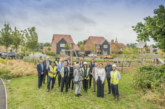 When it comes to solving the challenge of decarbonising heating in the UK’s social housing stock, no one size fits all. With such a diverse range of dwellings and communities to cater for, there are many factors to consider when specifying a low carbon solution for social housing. Craig Dolan, Product Manager — renewable systems at Valliant Group, discusses.
When it comes to solving the challenge of decarbonising heating in the UK’s social housing stock, no one size fits all. With such a diverse range of dwellings and communities to cater for, there are many factors to consider when specifying a low carbon solution for social housing. Craig Dolan, Product Manager — renewable systems at Valliant Group, discusses.
Delivering the Government’s pledge of being carbon neutral by 2050 is a challenge for all areas of society. However, given that in EU properties heating and hot water alone account for 79% of total final energy use, how we will sustainably heat homes in the future is an increasingly important question. For local authorities and housing associations charged with improving heating in their housing stock, it is a task made harder due to the huge variety of buildings across the country. But with daily headlines about climate change dangers, and the need as a society to lessen our reliance upon fossil fuels to provide the energy we need, pressure is on to create and utilise alternative technologies that will reduce our impact on the planet.
This is where the benefits of modern, cost-effective and sustainable technologies, such as air and ground source heat pumps, should be considered by those charged with securing long-term heating answers for housing tenants. But before embarking on a proposed retrofit programme, it is essential to consider some key factors to ensure that any low carbon solution is correct for the project and is specified appropriately.
Fabric first
A fundamental consideration before any decisions are made is to conduct a thorough assessment of a building’s heat loss. This first step will determine what measures are required to improve the fabric of the building and reduce its heat demand. The calculations will reveal the heat load needed, which in turn will influence the choice of heat source. The assessment will also help ensure that all aspects of the heating system will be correctly sized.
Current system
After assessing the health of the building’s fabric and the amount of heat needed, the second consideration is current infrastructure. For off-grid properties, which may be supported by a ‘dry’ system such as electric storage heaters, there would be a need to introduce piping to carry heated water around the buildings. However, for projects already using a ‘wet’ system, such as oil or LPG, much of the legacy infrastructure can remain in place, saving time, resource, cost and disruption. If there is a particular need for high volumes of hot water, hot water cylinders powered by renewable energy sources should also be specified in conjunction with heat pumps.
Central or de-centralised
A centralised system allows for a single heat pump to provide heat and hot water to a number of separate properties, which can deliver economies of scale in terms of installation and maintenance costs.
The only drawback of this method is that issues could occur around potential heat loss as it travels from the heat pump to the outlying property. With individual properties being separately metered and tenants obviously wishing to only pay for the energy consumed, the system operator may be left with the energy cost shortfall.
From a decentralised system perspective, there will be cost considerations via the provision of individual heat pumps to separate properties, but this approach negates the energy loss and cost issue outlined above.
It is crucial for social landlords to engage with technology providers to ensure they are specifying the right solution. Vaillant’s specialist design team will survey a site in detail and perform thorough heat calculations to find a solution that works for landlords and tenants alike.
Tenant engagement
Regardless of the heat source solution chosen, it is vital to gain the support of tenants on the retrofit journey. Although the benefits of a new heating system using renewable energy may seem straightforward, there are bound to be concerns about how the changes would affect tenants’ lives. That’s why it is important to engage with them from the start to help them understand the reasons behind the switch, how the new technology will work, what the works would involve and how they and their community will benefit.
Industry is under scrutiny, but so are our homes. How we provide heating now and in the future for what can often be older and differing types of domestic properties impacts on our country’s ability to reach net zero emissions by 2050. Heat pumps are increasingly being viewed as an ideal way to lower energy bills for social housing tenants and alleviate fuel poverty.
For more information on Vaillant’s renewable systems click here: https://www.vaillant.co.uk/specifiers/products/renewable-systems/
Header image ©fotostar/AdobeStock









